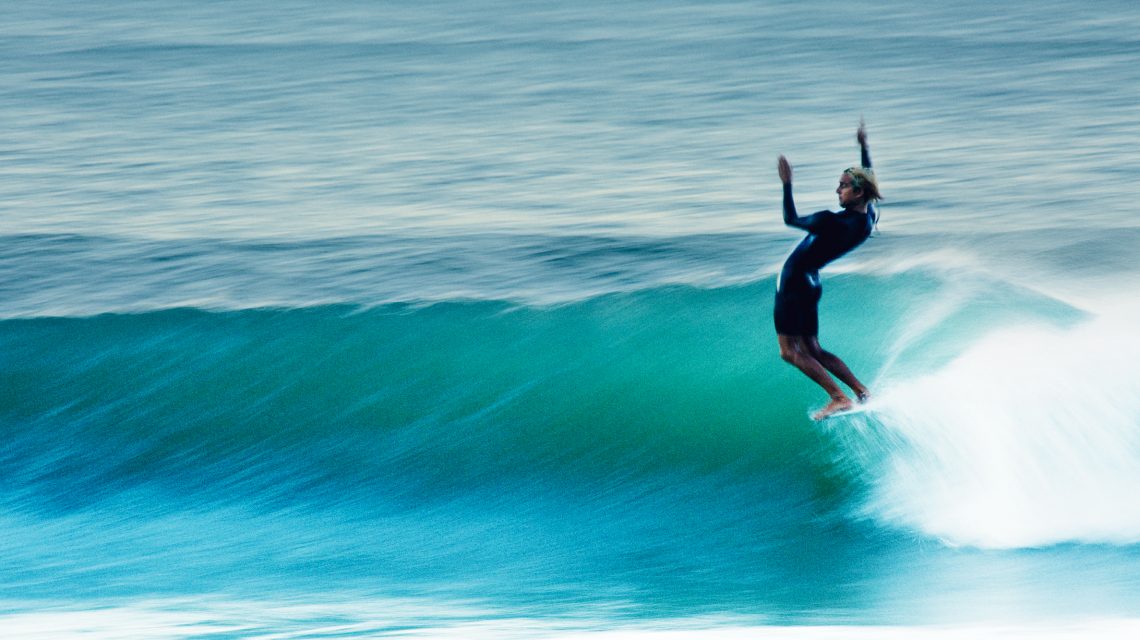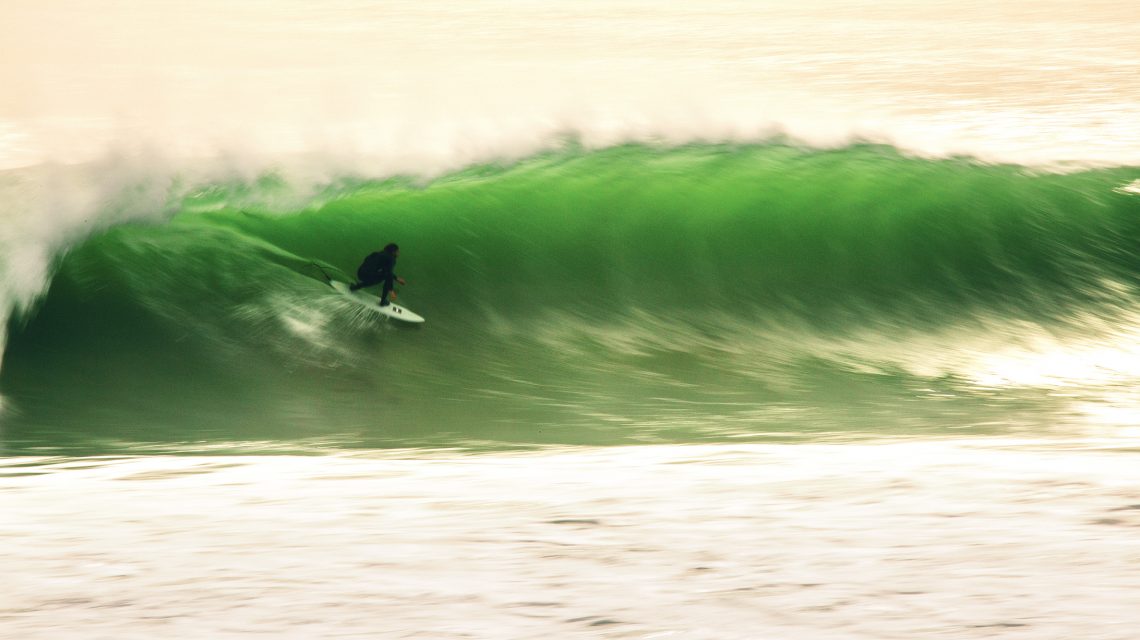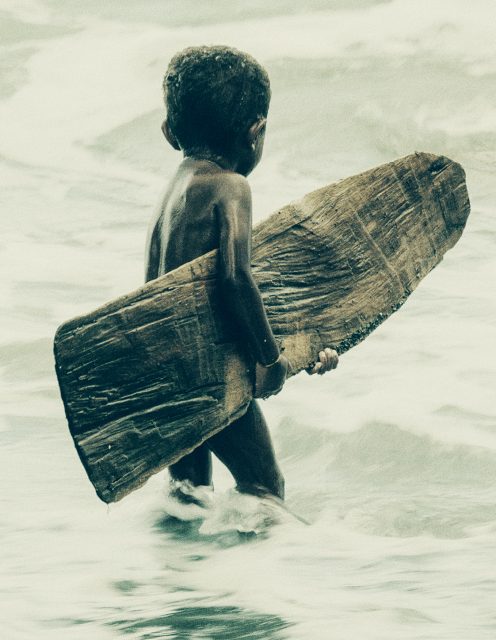Scope: Church Of The Open Sky
Share
Nathan Oldfield is a humble artist. In defiance of so many modern conceptions of artists as tortured, suffering martyrs, Nathan pieces together beautiful projects in the space between living a full life as a surfer, father, husband, devout friend and nearly 20 years as a schoolteacher. His “editing suite” is a standing desk nestled between the kids rooms and the family bathroom. He slaps on noise cancelling headphones and tinkers away at editing his movies as kids stream past and chores wait to be finished. His workflow is a refreshing reminder that making a creative contract with inspiration need not be your job, but a natural part of crafting a meaningful life.
Nathan recently completed his sixth film, The Church of the Open Sky, now available via Vimeo on demand. Like his previous films, including Seaworthy, Gathering and The Heart and the Sea, Nathan’s newest cinematic venture is further evidence of his poetic ability to reflect back to us the beauty of a surfing life – not only the visual beauty of our aquatic lives, but the rich blessing in how a surfing life feels.
SW: Why movie making?
NO: I’ve been passionate about surfing and surf films since I was a little kid. Watching a re-run of The Endless Summer on television as a six or seven year old while on Christmas holidays at my cousin’s house in Avalon had a big impact on me. I was just a grommet bodysurfing and messing around on boogieboards in the shorebreak at the time. But deep down in my heart I knew that I was going to be a lifelong surfer like my Dad and his brothers. Somehow I also felt that I had a surf film in me. That dream lay dormant for a long time, until my mid twenties, mostly because I was more focussed on surfing than I was on documenting it. But a lifetime of photography paved the way for a desire to create moving pictures.

Whose films shaped your early filmmaking?
Jack McCoy’s films had impacted my surfing imagination growing up. So had Sonny Miller’s beautiful Search films. They were profoundly influential for me. Eventually I got my hands on a video camera and began to play with shooting and editing.
Was there a niche of surf movies that you felt weren’t being made when you took to the camera?
At the time the surf film genre was almost exclusively saturated with the model that Taylor Steele pioneered: standard shortboard trick catalogues set to nineties’ punk. There were of course some notable exceptions, Andrew Kidman’s Litmus and Thomas Campbell’s The Seedling and Chris Malloy’s Thicker Than Water. But those kinds of movies were few and far between. It was especially the authentic storytelling in those movies that inspired me. They were the kinds of films that I gravitated to, and the kinds of films I wanted to make. Also, at a time when most of the surfing world had long been drinking the kool-aid of rockered-out, wafer-thin, hyper sleek and narrow thrusters, I had spent most of the nineties riding old singlefins and variations of fish and logs that I’d made in my backyard.
It’s quite remarkable how much more inclusive our culture is now, even compared to like 15 years ago…
For groms today, it’s actually hard to imagine how conservative the surfing world was back then. Some stoked old guys would paddle up to me and say they’d never seen anyone under fifty on a log. But generally the feedback was negative. I’d get called a kook for riding weird boards whenever I paddled out on a short wide twin fin. I regularly got told that I’d wreck my surfing. But I didn’t care, I actually liked the point of difference, and I just really enjoyed riding those kinds of boards. So I was interested in exploring these kinds of left of centre surfcraft in surfing films because that was what I was personally into, and because that kind of surfing wasn’t getting any real coverage in mainstream representations.
You’re not a full time surf moviemaker – if that even exists anymore. How do you make your films happen?
Teaching, either full time or part time over the last 19 years, has enabled me to make films. For years, when I was a full-time teacher I was able to collect footage during school holidays and edit during term. That way, I’d slowly build up enough material to release a surf movie. Also, I think, because filmmaking has never been my primary source of income, I’ve been able to make movies on my own terms. I haven’t had to conform to sponsor demands or even what may be appealing to the mainstream.

How has teaching shaped your worldview?
Being a primary school teacher has been a special career for me. Spending so much time with kids helps keep me young at heart in a way, to be in touch with my inner child. Ever since I was little, I’ve been a bit of a dreamer, a bit of a romantic. That inner child probably comes through in my films in some ways. And then as a father of my own kids, being a teacher is a great job. We go to school together. We come home together. We share school holidays together. I’m aware that this is a unique and rare privilege for dads in this day and age. I like that. It’s something I really value.
It must be pretty daunting to make longer movies in the age of ADD web clips. Are they still relevant?
All my life, I’ve had the desire to make things: surfboards, songs, poems, films, tracks on a wave. Surf films nurture that deep down innate longing I have to create things. Also, I value how significant surf films are to surfing culture. I have personally experienced how surfing films can change a life. That was how deeply films like The Endless Summer or Morning of the Earth affected me. So, I think you could say that I see my films as a way of giving back to surfing.
And how do you make something last in our culture of disposability?
I definitely want to make films that achieve a level of timelessness, unlike flash in the pan web clips. My way of attempting to achieve that is to focus on human stories that will always resonate with people. We are all social animals that gravitate to story telling. And I think the other way I try to make films that stand the test of time is to focus less on surfing performance and more on emotion. For a lot of us, surfing is a way of feeling our way through life, a way of being in the world. Surfing isn’t about what it looks like, it’s about what it feels like. To capture a sense of that in my filmmaking has always been at the forefront for me.
How long did it take to piece together your latest film, The Church of the Open Sky?
Close to two and a half years, from the first shot to completed edit. I’m not the world’s fastest surf filmmaker. Firstly, I’m a school teacher, so my working hours are limited. Also, if I’m honest, I’m a bit of a tinkerer and a perfectionist. I like to get things just right. A lot of artists will tell you that you never truly finish a painting or a book or an album or a film, you just eventually let it go.
Can you talk about where the title came from and why you chose it for this feature?
Well, the title is a paraphrase of an expression Tom Blake used. For those who don’t know, Blake was probably the most influential surfer of the first half of last century after Duke Kahanamoku. For Blake, surfing was a deeply personal, meaningful and spiritual experience. He was a self-professed pantheist, and coined the equation ‘Nature = God.’ I think that idea resonates with a lot of surfers. He likened surfing to worship under what he called ‘the blessed church of the open sky.’ I kind of always loved that line and one day it occurred to me that it would be a perfect title for the film that I was already shooting. The idea that surfing is a metaphysical activity, and not just a physical activity or sport, is something that I have felt throughout my surfing life. It’s a theme that’s already emerged in other films I’ve made. I also deeply believe that everything is sacred. Everything is holy. It’s all ‘church.’ So I feel strongly that the practice of surfing can be sacramental in that sense. That has genuinely been my experience. The other thing that I like about the title of the film is that it is inclusive for everyone. We are all under the church of the open sky. No one is excluded or left out in the cold. Everyone’s welcome. It’s a shared, communal thing. A universal fellowship. Plus, I just like how the phrase sounds – the church of the open sky – it’s romantic, dreamy, mysterious, gentle. I like that kind of stuff. But the film doesn’t explicitly explore these kinds of ideas. Mostly because I never like to get preachy or to beat people over the head with ideas. They are just themes in the film that perhaps may subtlely come through.
What was the most illuminating moment from making The Church of the Open Sky?
Ah, there were so many moments of pure joy in making this film. It’s hard to pick just one. I don’t want to give too much away, but while shooting the opening sequence of the film in remote Papua New Guinea, I was able to witness some kids surfing in front of their village along a little patch of reef in the middle of nowhere. It was the most elemental, pure surfing that I have ever personally seen. Just flawless, natural, uncontrived play. It was a reminder to me that surfing is so universal and simple and somehow so beautifully human. I had goosebumps and tears in my eyes while shooting. I feel enormously fortunate to have been able to document that kind of surfing in the film. The other experiences that I’m grateful for are all the travel moments I was able to share with my family and close friends while making the film.

Fatherhood and family are strong themes in your work. Is that the case with The Church of the Open Sky?
Yes, for sure. My films are generally an extension of my own surfing life. What I mean to say is that filmmaking is part of what I do as a surfer, like fixing my own dings or making my own boards or taking photographs of the sea. So, I think it’s natural for the things that are most precious to us in life – healthy relationships with family and friends – to be celebrated in surfing films. Again, these messages in the film are quite subtle, but they are themes that keep arising in my work, almost of their own accord.
You’ve chosen to independently make and distribute your latest movie. Why?
It’s an interesting time to be a surf filmmaker, in this brave new world of digital distribution. It’s almost like I have my feet in both worlds. I am still going to release a limited run of DVDs, because I regularly get reminders that some of my audience still like DVDs. They want to hold something in their hands. I’ll be releasing those DVDs independently through my own website. Then eventually I am going to make the film available for digital download via Vimeo-On-Demand. It’s a great platform for indie filmmakers like me because it enables you to side-step the distribution middle-man who usually takes a cut of over half a film’s profit. But at the same time it’s a bit of an experiment for me to go out on my own with distribution. It’s a risk because I’ve poured so much of myself into this film, my time, my money, my energy and my heart. But because I’m a self-funded independent filmmaker, I want to have a shot at being independent in how I share the film with the world.
Can you describe the journey that Church takes the viewer on?
The film is shot in Australia, New Zealand, Papua New Guinea and Sri Lanka. So it has a bit more on exotic, island vibe than other films I’ve made in the past. It takes the viewer on a journey through these places. I think a lot of us who have experienced the gift of travel would agree that as we are travelling through places we are also journeying within ourselves. It can be a very transformative experience. And because, as I said earlier, everything is sacred, then travel can also be seen as a kind of pilgrimage. Somehow, surf trips can become bigger and richer and more generous than we might first imagine.